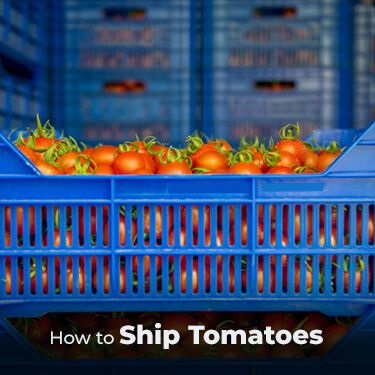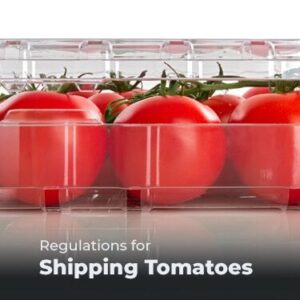
By
 Copy URL to Clipboard
Copy URL to Clipboard
Shipping tomatoes from Mexico takes some careful planning to ensure the tastiest product reaches consumers. Transporting your tomatoes incorrectly could cause your hard-earned harvest to spoil or become damaged in transit.
Key Takeaways
With the following tips, you’ll be able to ship tomatoes from Mexico to the United States without spoiling your bottom line.
Mexico is the top trading partner with the U.S. for a number of goods, and tomatoes are no exception. To illustrate this, I’ve compiled five years worth of data on the amount and dollar value of fresh or frozen tomatoes imported to the U.S. from Mexico.
Shipments of Fresh or Chilled Mexican Tomatoes to the USA 2019-2023
| Year | Value in 1,000s of USD | Quantity in KG |
| 2023 | $3,279,274 | 1.82 billion |
| 2022 | $2,581,264 | 1.8 billion |
| 2021 | $2,485,157 | 1.75 billion |
| 2020 | $2,482,253 | 1.67 billion |
| 2019 | $2,075,401 | 1.7 billion |
Obviously, consumer demand for tomatoes is high in the U.S., and Mexican produce farmers can reap financial benefits by exporting their goods. To understand how that process works, let’s start by looking at harvesting and packaging procedures.
Related: Shipping Vegetables From Mexico to USA
Tomatoes are generally shipped in one of the following two conditions:
This distinction is important because it will dictate the stage at which you harvest your crop and ideal shipping conditions. For the purposes of this article, I’ll mostly focus on fresh tomatoes, since canned varieties aren’t as susceptible to damage or spoilage in shipping.
Fresh tomatoes are picked while they are still green, and ripened en route to their final destination by exposing the vegetables to their natural ripening hormone, ethylene. Tomatoes used for canning or sauces are picked while they are red and already ripe, so they can be processed and canned y within a matter of hours.
Related: Shipping Avocados From Mexico to the United States
Ideally, fresh tomatoes should be packaged in fruit crates with vent holes. This allows air to circulate throughout the container during shipment, ensuring all the tomatoes experience the correct temperature and humidity levels. Jointed boxes, tubs, cartons, and trays are also commonly used to package these vegetables.
Tomatoes can be packed directly on top of each other without being bruised because years of selective breeding have left the vegetables with thick skin. Most tomato varieties have a fairly uniform size, which allows them to be packed together more easily.
Fresh tomatoes need particular temperature, humidity, and ventilation conditions while in transit. This requires the use of a refrigerated, or “reefer”, truck with adjustable humidity controls. If any of the conditions are off, your shipment is likely to arrive in unacceptable condition.
The optimal temperature range to ship fresh tomatoes is 55-60°F, or 12.7-15.5°C, with an 85-90% relative humidity. Shipping them below or above this range can cause issues, such as:
Tomatoes don’t do well with sudden fluctuations in temperature and humidity. For example, if they’re shipped in a low-humidity environment of 64°F and suddenly exposed to a high-humidity environment of 86°F, condensation will occur on the surface of the tomato and negatively impact the quality of the vegetable.
 Regulations for Shipping Tomatoes From Mexico
Regulations for Shipping Tomatoes From Mexico Picking, packing, and arranging transport for your tomatoes are just parts of the overall process. There are several regulations you’ll need to follow in order to ensure your fresh tomatoes can make it into the U.S. for sale.
Two of the most important regulations you’ll need to follow involve:
These rules are in place to ensure fair competition with Florida-grown domestic tomatoes.
Between the dates of October 10 and June 15, tomatoes from exporters outside the U.S. must have a minimum diameter of 2 and 9/32 of an inch, or approximately 58.42 mm. They must also meet a quality grade of U.S. no 2 or higher.
To meet this grade, tomatoes must be:
If your shipment of tomatoes does not exceed 60 lbs (27.2 kg), these regulations don’t apply.
Facilities exporting food to the United States must register their business with the U.S. Food and Drug Administration (FDA). This is in accordance with the Food Safety Modernization Act (FSMA), which also mandates the following.
The full list of FDA requirements for food products imported into the U.S. can be found here.
Additionally, the importer should be prepared for the possibility that the shipment will be inspected at the border. The FDA works with Mexican government inspection agencies to ensure farmers meet U.S. standards for quality, but Customs and Border Protection may still perform inspections to ensure foreign pests and sub-par foodstuffs don’t enter the U.S. market.
Related: Cross Border Freight Companies: What to Look For
The consistent demand for tomatoes in the U.S. means it shouldn’t be hard to find a buyer for your crops, but ensuring that the shipment arrives in good shape can be difficult. By working with experts in cross border freight and logistics, you can go a long way toward setting yourself up for success. That’s where we come in.
At R+L Global Logistics, our network of premium carriers in Mexico provide you with secure door-to-door less than truckload (LTL) and full truckload (FTL) services. We cover the entire country and can move cargo across all major US/Mexico border gateways.
Our Mexico logistics experts put their knowledge of border operations to work for you, keeping your shipment moving hassle-free to its destination.
We work closely with all parties of the logistics process to facilitate:
Our team is trained to manage the complexities of international shipping and effectively translate to our customers the various requirements of customs clearance and efficient cargo transportation.
If you’re ready to schedule your shipment, give us a call at (866) 335-0495 or contact us online today. When it comes to shipping tomatoes, we’ll produce the results you need.
 Copy URL to Clipboard
Copy URL to Clipboard

Hello! I am looking to start up my own business with wholesale fruits and vegetables. Do you guys know any growers that work with you all I can get product from in Mexico? Thank you